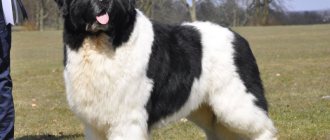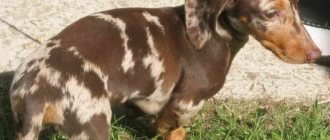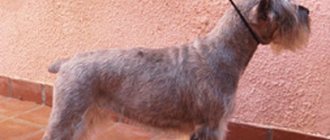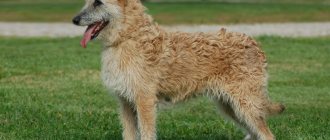Dossier
Adult height: 17-23 cm. Weight: 2-3 kg. Characteristic color: completely black, black and tan. Coat length: long, with thick undercoat. Life expectancy: 12-16 years. Advantages of the breed: a cheerful, active dog with beautiful soft fur; Easy to train and socialize even into adulthood. Difficulties of the breed: sheds a lot of hair during molting, requires painstaking care; in behavior may show selfishness and attempts to dominate people and other animals. Price for a black Pomeranian or black and tan Spitz: $400-1200 depending on the kennel, pedigree, proportions and tan color. Classification: small decorative dog.
Red shade
“Pomeranians” of red color are currently the most famous and numerous.
According to the standard, it is this coloring that allows for lighter shades of some parts of the dog’s body: the muzzle, ears, “panties,” and the tip of the tail. It should visually look as if the wool in these places is slightly faded, that is, the color should differ by no more than half a tone.
Character
The Black Spitz boasts a cheerful, mischievous disposition. The dogs are very active, so given the right reason they will run, jump, frolic and bark loudly. Spitz dogs easily get along with people, even when they grow up, so you can leave your pet with friends without fear that there will be problems with it.
These kids love affection very much and without it they become emotionally unstable and aggressive. Spitz take on some of the traits of their owner: if the owner is cheerful and active, then the dog will be exactly the same, and if the owner is a homebody and a bit of a walker, then the Spitz will begin to appreciate the comfort of home.
As for the Spitz’s relationship with other animals, it’s not so rosy. A small dog is quite brave and will try to dominate other dogs, even if they are significantly larger than the Spitz. They can also use a beating to meet an animal that has entered their territory. This is explained by the fact that Spitz dogs still have the genes of a guard dog in their blood, so they will defend their home with all the ferocity.
Note! It is difficult for a Spitz to get along with a cat - conflicts and fights can arise between animals.
Pomeranian Spitz. Origin
The Black Pomeranian is often called a royal dog breed . It is no coincidence that this small sociable dog was extremely loved by the nobility and people from royal families.
Back in 1700, in the town of Pomerania (the region between eastern Germany and western Poland), Spitz wolves appeared, something between a dog and a wolf. It was assumed that these animals emigrated to Pomerania from Russia and Serbia.
Through the inbreeding of the Spitz wolf and ordinary dogs, today's Pomeranian Spitz eventually appeared (according to found records from the archives).
The ancestors of modern Spitz dogs were used as guards, shepherd's assistants and even sled dogs. The fact is that initially Spitz weighed about 15-17 kg and could easily pull a team. Smaller dogs were kept at home as pets. The colors of the “ancient” Spitz were most often black, brown, cream and white.
In 1761, the wife of King George III, Queen Charlotte, saw small dogs. In the process of meeting and communicating with the animals, they conquered the queen with their cheerful, easy-going disposition and infectious cheerfulness. Charlotte took two Pomeranian dogs with her to her homeland. The dogs were named Phoebe and Mercury, and they took root in Great Britain. The queen's heart forever remained with this breed; artists painted several paintings depicting royal dogs.
How to choose a puppy
A Spitz puppy must be healthy, socialized and meet the requirements for the breed, so it is best to choose a professional kennel recognized by international dog breeding organizations. Yes, in this situation the puppy will cost more, but the end justifies the means.
Healthy puppies are very curious and easily make contact with strangers; their coat should be soft, silky and clean; the norm is clear eyes without streaks, pink gums and conjunctivae of the eyes, a cold, wet nose; There should be no inguinal or umbilical hernias.
The breed standard is as follows: an elongated but not pointed muzzle; erect, close-set triangular ears; deep wide chest; straight back with a short lumbar belt; paws are rounded, medium tail is high. In addition to the classic black color, Pomeranians can also be black and tan.
This is expressed in red and fawn areas around the eyes, chest, paws and under the tail. Breeders also distinguish the types of black Pomeranians: fox type, bear type, toy type. Fox Spitz have a more elongated and sharp muzzle, while bear and toy Spitz have a flattened and rounded muzzle.
Sable shade
One of the common colors of the same type is sable. But it can only be called the same type based on genetic criteria. Upon examination, it becomes clear that this shade consists of two colors: the guard hair has a zonal gray tint, and the undercoat can be red, cream or gray.
Some experts agree that this color should be called zonal. Based on this, sable color is divided into three types:
- red sable;
- creamy sable;
- zonal gray.
The main difference between the sable shade is that the muzzle and ears are the same color.
Care and maintenance
The Black Pomeranian Spitz is an indoor breed of dog, so for good socialization of the animal it is necessary to live next to a person, and not in an enclosure, and especially not on a chain. It is best to walk your Spitz twice a day, so that the dog can have a good run and throw out the accumulated energy.
At home, a Spitz can even be trained to use a litter tray if there is not enough time for walking. The animal's fur requires close attention, as it is thick and long. Every 3-4 days they need to be combed out first with a “slicker brush” and then with a regular comb . You need to bathe as needed when dirty and during heavy shedding. It is also important to take care of your Spitz’s teeth – brush them with a special brush and paste to prevent periodontal disease from developing.
History of appearance
Spitz-type dog breeds have been known for centuries. At first they were very large dogs with a pointed muzzle, erect triangular ears and a fluffy tail curled into a ring.
Black Spitz - little bear
Even experienced dog breeders cannot say for sure when this or that color appeared, but black Spitz dogs have definitely existed a long time ago.
For your information! The breed originates in Germany. It was there that these animals began to be bred as guard dogs. After this, Spitz appeared in England, where they began to breed decorative breeds.
Training
Black Pomeranians are very intelligent and easy to train. There is no need to use strict methods; it is usually enough to say it once to achieve the desired effect. Spitz dogs love to surprise their owners with various touching “numbers”. Working with the Spitz's voice will be a good bonus for you: these dogs are very easily excited and accompany events with a long, loud, barking sound.
Advantages and disadvantages
The main advantages are considered to be the large supply of energy and cheerfulness of this dog. Spitz dogs are easy to train and achieve great success in this, mastering circus and acrobatic tricks and coming into contact with people. They love children very much and do not hurt them. In terms of cleanliness they are comparable to cats. By dog standards they are long-lived.
Among the obvious disadvantages, one can note the animal’s slight excitability, accompanied by a loud, high-pitched bark, which can last for quite a long time. Also, the fearless nature of the Spitz clearly does not correspond to its size , so the owners will have to be careful with it on the street and when in contact with other dogs.
This is the breed, these black Pomeranian Spitz. In return for your care, the little dog will give you his love and affection and become your family’s best friend. What do you think about the methods of raising Spitz dogs and teaching them various tricks? What nicknames would suit a black Spitz best? Write your options in the comments. Love your four-legged friends!
Black color - defect or breed
A Spitz may have a non-standard coat color, and this is not considered a defect. According to canine standards, medium and small representatives of this breed can have a variety of coat colors. The coat can range from white and red to chocolate and black.
Black
White dog: breeds of fluffy white dogs
According to the standard, a black Spitz should have dark skin, as well as an undercoat and nose that are also dark in color. There are situations when, when crossing dogs of different colors, puppies are born with small light spots on the undercoat. In this case, the animals do not meet generally accepted standards, but despite this, they are still allowed to participate in exhibitions.
Note! A black Pomeranian may lighten a little over time. Small discolored areas appear on his undercoat.
A black Spitz's coat should be dense and abundant, consisting of a thick undercoat and long, coarse guard hairs. For purebred representatives of this breed, it should be perfectly smooth, without a hint of waves or curliness. In the neck area, the wool forms a chic collar, which in appearance looks more like a mane.
The coat of purebred representatives of this breed should be harmonious and complete.
Black and white
Another common variety of spotted colors. Representatives of this color can only be crossed with each other. It is not recommended to breed animals with monochromatic representatives of this breed.
Black markings on such animals are located on the ears, tail and muzzle. The black and white Spitz looks very impressive.
Black and white spitz puppy
Black and Tan
This type of dog has a deep black color as its base tone. The Black and Tan Spitz has patches of sable or orange. Tan can be under the eyes, on the chest and paws. This variety of Spitz is very popular.
Spitz black and tan
Brown
A fairly common specimen is the chocolate-colored Spitz. In this case, the animal should not have inclusions. Experts recognize only a uniform shade of coat.
For your information! The nose and lips should also be brown. If a puppy has them black, then the dog will not grow up to be a full brown color.
Spitz dark chocolate color











